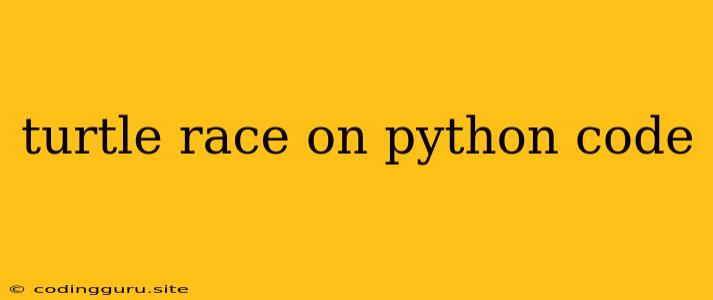Want to spice up your Python learning? Let's build a Turtle Race!
Python's turtle module is a fantastic tool for beginners to dive into programming, and a turtle race is a fun way to put those skills to the test. This article will guide you through creating a simple yet engaging turtle race in Python.
Getting Started: Set Up Your Track
- Import the Turtle Module: Begin by importing the necessary modules:
import turtle
import random
import time
- Create the Screen: Set up the canvas for your race:
screen = turtle.Screen()
screen.setup(width=500, height=400)
screen.title("Turtle Race!")
- Define Your Racers: Create a list to hold your turtles. For this example, we'll have six turtles:
colors = ["red", "orange", "yellow", "green", "blue", "purple"]
turtles = []
for i in range(6):
new_turtle = turtle.Turtle(shape="turtle")
new_turtle.penup()
new_turtle.color(colors[i])
new_turtle.goto(-230, -100 + (30 * i)) # Starting positions
turtles.append(new_turtle)
The Race Begins!
- Adding Random Movement: Each turtle will move randomly with a set distance.
def move_turtle(turtle):
random_distance = random.randint(0, 10)
turtle.forward(random_distance)
- Race Loop: The race logic is handled by the
whileloop.
while True:
for turtle in turtles:
move_turtle(turtle)
if turtle.xcor() > 230:
winner = turtle.color()[0] # Get winning color
print(f"The {winner} turtle won!")
time.sleep(2) # Pause for 2 seconds
break
Finishing Touches
- Adding Obstacles: Add obstacles like rocks or a finish line to make the race more challenging.
# Create a finish line
finish_line = turtle.Turtle()
finish_line.penup()
finish_line.goto(230, 100)
finish_line.setheading(270)
finish_line.pendown()
finish_line.forward(200)
- Adding Betting: You can add an element of betting. Create a simple bet system where the user can choose a turtle to bet on before the race begins.
Running Your Turtle Race!
Now, let's bring it all together and run your creation.
screen.listen()
screen.exitonclick()
Tips & Tricks
- Speed Control: Use
turtle.speed()to control the animation speed. Higher numbers mean faster speeds. - Customizations: Add more turtles, change their shapes, or modify their movement for more variety.
- Obstacles: Experiment with different obstacle shapes and placement.
- Betting System: Develop a simple betting system with user input to make the game more interactive.
Let's Put It All Together
import turtle
import random
import time
screen = turtle.Screen()
screen.setup(width=500, height=400)
screen.title("Turtle Race!")
colors = ["red", "orange", "yellow", "green", "blue", "purple"]
turtles = []
for i in range(6):
new_turtle = turtle.Turtle(shape="turtle")
new_turtle.penup()
new_turtle.color(colors[i])
new_turtle.goto(-230, -100 + (30 * i)) # Starting positions
turtles.append(new_turtle)
# Create a finish line
finish_line = turtle.Turtle()
finish_line.penup()
finish_line.goto(230, 100)
finish_line.setheading(270)
finish_line.pendown()
finish_line.forward(200)
def move_turtle(turtle):
random_distance = random.randint(0, 10)
turtle.forward(random_distance)
while True:
for turtle in turtles:
move_turtle(turtle)
if turtle.xcor() > 230:
winner = turtle.color()[0] # Get winning color
print(f"The {winner} turtle won!")
time.sleep(2) # Pause for 2 seconds
break
screen.listen()
screen.exitonclick()
Conclusion
This turtle race is a simple introduction to building interactive games with Python. You can easily expand upon this basic structure, adding features, customizing the appearance, or even adding more complex gameplay elements. The turtle module is an excellent resource for learning Python's fundamental concepts while creating enjoyable projects. Have fun with your turtle race!
